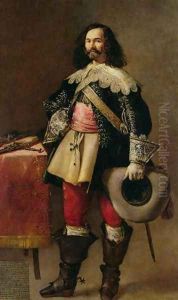Fray Juan Andres Rizi Paintings
Fray Juan Andres Rizi was a multifaceted figure in the 17th century, embodying the roles of a painter, engraver, and Benedictine monk within the context of the Spanish Golden Age. Born in 1600 in Spain, his life was a blend of religious devotion and artistic pursuit, illustrating the complex interplay between faith and art that characterized the period. Rizi's contribution to the arts was significant, especially in the realm of religious painting, where his works are noted for their spiritual depth and technical proficiency.
Rizi came from a family with artistic inclinations; his brother, Francisco Rizi, was also a renowned painter of the time. This familial background provided Juan Andres with an environment conducive to developing his artistic talents from a young age. Opting for a life that combined his spiritual and artistic interests, he joined the Benedictine order, which not only offered him a religious outlet but also opportunities to engage with art in a religious context. Throughout his life, Rizi balanced his monastic duties with his passion for painting, becoming known for his work on religious themes, which were typical of the Counter-Reformation period.
His artistic style is characterized by a deep sense of piety and a keen attention to religious iconography, traits that made his works resonate well within ecclesiastical circles. Rizi's paintings often featured biblical scenes and saints, rendered with a vividness and emotional intensity that sought to inspire devotion and reflection in the viewer. Despite the prominence of religious motifs, his work also displayed an adeptness with naturalistic details and a mastery of light and shadow, showcasing his skill in bringing spiritual subjects to life with a sense of realism and humanity.
Fray Juan Andres Rizi's legacy is not just in the paintings he left behind but also in his contribution to the cultural and religious life of Spain during the 17th century. His works can be found in various churches and monasteries, serving as a testament to his skill and devoutness. Rizi passed away in 1681, leaving behind a body of work that continues to be appreciated for its artistic quality and its role in the religious and cultural history of Spain. His life and work exemplify the blend of spirituality and art that was a hallmark of the era, making him a notable figure in the history of Spanish art.
